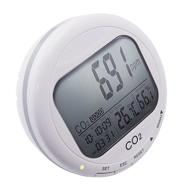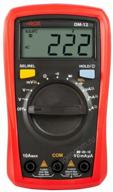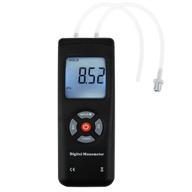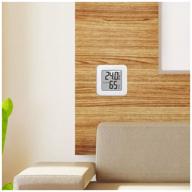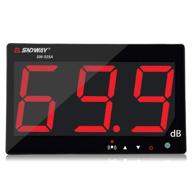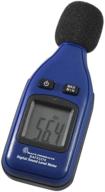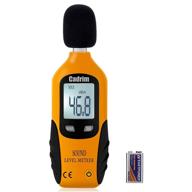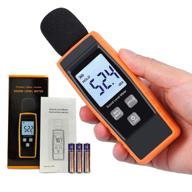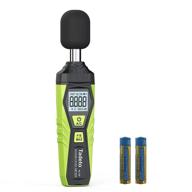Another interesting products
How to accurately measure sound levels?
Measuring sound levels accurately is important for controlling noise pollution, complying with occupational safety regulations, and creating comfortable environments. Here are some tips for accurate sound level measurements:
Use the right meter
Choose a sound level meter that meets international accuracy standards like IEC 61672 Class 1 or Class 2. Avoid using smartphone apps which may not have accurate built-in microphones. Meters like the Cadrim Digital Sound Level Meter provide reliable measurements.
Select the appropriate weighting
The A-weighting scale should be used for general environmental noise measurements as it reflects the human ear's frequency response. C-weighting is better for measuring low frequency sounds. Choose fast or slow response as needed - fast for sudden sounds, slow for average ambient levels.
Calibrate the meter
Sound level meters need regular calibration, usually done annually by the manufacturer, to ensure the microphone and electronics are working properly. Calibrate the meter before each use with the acoustic calibrator provided.
Take measurements correctly
- Point the meter microphone towards the noise source.
- Avoid reflections by keeping the meter away from surfaces.
- Take measurements at ear height for assessing human exposure.
- Record minimum and maximum levels, not just averages.
- Take measurements at multiple locations if needed to survey a large area.
Following good measurement technique ensures your sound level readings are accurate for your intended application.
Similar products
How to control noise pollution?
Noise pollution has negative effects on human health and well-being. Here are some effective ways to control noise pollution:
Use noise barriers
Constructing barriers between noise sources and receivers can block sound transmission. Common barriers include:
- Solid walls or embankments along highways
- Fences around industrial facilities
- Enclosures around loud machinery
Barriers should be tall enough and long enough to interrupt the line of sight between source and receiver. Vegetation strips can also act as barriers.
Control at the source
Reducing noise at the source is most effective. Methods include:
- Choosing low-noise equipment and machinery
- Installing silencers and mufflers
- Using sound-dampening enclosures
- Siting noise sources away from sensitive receptors
- Reducing vehicle and aircraft engine thrust in sensitive areas
Enforce noise regulations
Governments can enforce regulations on noise limits for different sources such as:
- Maximum noise levels for vehicles and construction equipment
- Aircraft takeoff and landing noise limits
- Industrial facility noise limits
- Limits on hours of operations for noise-generating activities
Measurement and monitoring using sound level meters is needed to implement noise regulations.
Public education
Informing people about the impacts of noise and how they can mitigate problems helps build public support for noise control.
A combination of these noise control methods is needed to effectively reduce noise pollution in urban environments.
How to use a sound level meter?
Using a sound level meter properly is key to getting accurate noise level measurements. Here are some tips on using these devices:
Choose the right meter
Select a meter suitable for your application - general purpose, occupational noise, environmental noise, etc. Look for features like:
- Accuracy - Class 1 or 2 as per IEC 61672
- Frequency weighting - A, C, Z
- Response time - Fast, Slow
- Data logging capacity
- Tripod mount for long term monitoring
Set the parameters
Adjust the meter settings before starting measurements:
- Set frequency weighting to A or C as required
- Select fast or slow response time
- Choose appropriate measurement range (30-90 dB, 60-120 dB etc)
- Set averaging time to 1 sec or longer if needed
Calibrate the meter
Calibration ensures accuracy. Use the supplied acoustic calibrator to calibrate before each use. Set meter to calibration mode, insert microphone into calibrator cavity, turn on calibrator and adjust meter to match calibrator's reference tone level.
Take measurements
- Point microphone towards noise source and avoid reflections.
- Observe from a distance to avoid affecting readings.
- For average ambient levels, take measurements from multiple locations.
- Record LAeq, LAFmax, LAFmin values as needed.
Download and analyze data
For long term monitoring, download stored data to a computer for analysis. Generate detailed reports showing variations over time. Compare to noise regulations and standards.
Properly using a sound level meter provides the accurate noise level data needed for various applications.
Top products in 🎤 Sound & Noise Meters
How to calibrate a sound level meter?
Calibration is essential for ensuring the accuracy of sound level meter measurements. Here are the key steps involved:
Get a calibrator
An acoustic calibrator that meets IEC 60942 Class 1 or 2 specifications is required. Popular types include:
- Pistonphone - produces constant tone at 250Hz
- Sound level calibrator - produces 1kHz tone
The calibrator should have a known calibration level traceable to national standards.
Set up calibration
To calibrate the sound level meter:
- Turn on and warm up meter for recommended time e.g. 5 minutes.
- Set meter to calibration mode according to manual.
- Insert microphone into calibrator cavity, ensuring airtight fit.
- Turn on calibrator and set tone level e.g. 94 dB.
Adjust meter to match calibrator
The meter display should show the same sound level as the calibrator tone level. If not, adjust the meter calibration controls until the displayed level matches the calibrator. Save calibration adjustment.
Repeat for all settings
Repeat the calibration process for all meter settings - frequency weightings A, C, Z; fast and slow response times. This ensures accuracy across measurement parameters.
Calibrate before each use
Environmental conditions like temperature and humidity changes can affect calibration. Get into the habit of calibrating the meter before each use for reliable readings.
Proper calibration according to the user manual is essential for getting accurate, reliable results from a sound level meter.
How to select the right sound level meter?
Choosing the appropriate sound level meter for an application is important for accurate noise level measurements. Consider these key factors:
Intended use
Determine if you need a general purpose, occupational/industrial hygiene, environmental or community noise meter based on your measurement application.
Accuracy level
Sound level meters are available in different accuracy grades based on IEC 61672 standards:
- Class 1 - Most accurate for reference measurements
- Class 2 - High accuracy for field use
- Class 3 - General purpose grade
Choose Class 1 or 2 meters for legally enforceable occupational and environmental noise monitoring.
Frequency weightings
Check if the meter supports common weightings like A, C, Z used for different types of measurements:
- A-weighting - Overall sound levels
- C-weighting - Low frequency noise
- Z-weighting - Unweighted broad spectrum
Measurement parameters
Look for capabilities like Leq, Lmax, Lmin, LN percentile levels; slow, fast and impulse response times; and frequency analysis features like octave or 1/3 octave filters.
Data logging and analysis
Long term and unattended monitoring requires sound level meters with large data memories, logging/downloading software and reporting features.
Selecting a meter well-matched to the application ensures accurate, reliable noise level measurements.
How to get started with noise monitoring?
Noise monitoring is the process of measuring and analyzing sound levels using specialized equipment. Here are some tips for beginners to get started:
Determine monitoring goals
Decide why you want to monitor noise - assess workplace hazards, evaluate environmental impact, ensure compliance with regulations etc. This guides equipment selection and monitoring plan.
Get a sound level meter
A sound level meter meeting IEC 61672 Class 1 or 2 standards provides accurate, reliable measurements. Key features include:
- A, C and Z frequency weightings
- Fast, slow and impulse response times
- Time logged data recording
- Octave or 1/3 octave band filters
Learn monitoring techniques
Read the meter manual and guides to understand good measurement practices like:
- Proper microphone placement
- Avoiding reflections
- Sufficient sampling duration and times
- Calibration methods
Develop monitoring plan
Document details like measurement locations, parameters, durations, timing, analysis methods based on monitoring objectives and relevant standards or regulations.
Analyze and report data
Use meter software or spreadsheets to examine trends/exceedances. Generate charts, tables and write reports summarizing findings and recommendations.
With the right equipment, knowledge and plan, noise monitoring can be used effectively to control noise hazards and improve acoustic environments.
How to use your Amazon Prime to buy the Cadrim Digital Sound Level Meter
The Cadrim Digital Sound Level Meter is an accurate and reliable tool for measuring noise levels. Here is how you can use your Amazon Prime membership to purchase this device conveniently:
Find the product listing
Go to www.amazon.com and search for "Cadrim Digital Sound Level Meter" using the search bar. Make sure the listing is sold directly by Cadrim and states "Prime Eligible" for fast, free delivery.
Check price and availability
On the product detail page, verify the price is within your budget. Also check that the meter is in stock and can be delivered to your location. Select the quantity you need - the meters often come in single, double or multi-unit packs.
Add to cart
Once you have confirmed the details, click the "Add to Cart" button to add the sound level meter to your shopping cart. Make any other selections like optional accessories if required.
Proceed to checkout
When ready, click the cart icon at the top of the page and proceed to the checkout process. As a Prime member, you will see the delivery estimation showing free one or two day delivery.
Select delivery address
On the checkout page, confirm or add your preferred shipping address. Double check that your address is complete and accurate to avoid any delivery issues.
Complete payment
Finally, select your payment method stored in your Amazon account and complete the transaction. Your Cadrim sound level meter will soon be on its way!
With Amazon Prime's fast shipping, you can get this professional grade noise monitoring equipment conveniently delivered right to your door.
How To Use Cadrim Digital Sound Level Meter For Accurate Measurement?
To use the Cadrim Digital Sound Level Meter for accurate measurement, follow these steps:
- Turn on the meter by pressing the power button.
- Hold the meter at the desired location and distance from the sound source.
- Wait for the reading to stabilize on the screen.
- Record the reading or take a screenshot for future reference.
- Repeat the process at different locations or times to get a more comprehensive measurement.
- If needed, calibrate the meter before use by following the manufacturer's instructions or watching a tutorial video.
- Maintain and care for the meter to ensure optimal accuracy and longevity.
What Are The Different Modes Of Operation For Cadrim Digital Sound Level Meter?
The Cadrim Digital Sound Level Meter has two modes of operation, which are:
- Fast mode: This mode provides a real-time measurement of the sound level and is suitable for measuring sudden or brief noises.
- Slow mode: This mode provides an average measurement of the sound level over a longer period and is suitable for measuring continuous or steady noises.
The meter also offers four measurement parameters, which are Lp (sound pressure level), Leq (equivalent continuous sound level), Lmax (maximum sound level), and Lmin (minimum sound level). It can measure noise levels from 30 to 130 decibels and features a max/min hold function that allows you to capture the highest and lowest values. The meter can measure sound levels within seven different ranges, each covering 20 dB, and the number of each range represents the center of the range. The instrument is commonly a hand-held device with a microphone, and the best type of microphone for sound level meters is the condenser microphone, which combines precision with stability and reliability.
What Are The Four Measurement Parameters Offered By Cadrim Digital Sound Level Meter?
The Cadrim Digital Sound Level Meter offers four measurement parameters, which are:
- Lp (sound level): This parameter measures the instantaneous sound pressure level and is suitable for measuring sudden or brief noises.
- Leq (Equivalent Continuous A Sound Level): This parameter measures the average sound level over a period of time and is suitable for measuring continuous or steady noises.
- Lmax (Maximum Sound Level): This parameter measures the highest sound level reached during a measurement period and is suitable for identifying peak noise levels.
- LN (Percent of all readings): This parameter measures the percentage of readings that exceed a certain sound level and is suitable for assessing noise exposure levels.
The meter has a measurement range of 30dBA ~ 130dBA, an accuracy within +/- 1.5 dB, and a resolution of 0.1dBA. It also features a large LCD screen and a 15-minute automatic shutdown. The instrument is commonly used to test the sound level of the environment, machinery, vehicles, ships, and other noise sources.
What Is The Difference Between Lp And Leq Measurement Parameters?
Lp and Leq are two different measurement parameters offered by the Cadrim Digital Sound Level Meter. Lp measures the instantaneous sound pressure level, while Leq measures the average sound level over a period of time. Lp is suitable for measuring sudden or brief noises, while Leq is suitable for measuring continuous or steady noises. Although Leq is often described as the "average" noise level during a noise measurement, it is technically not correct. Leq represents the total sound exposure for the period of interest or an energy average noise level for the period of interest. Lp, on the other hand, is the sound pressure level at a specific moment in time. Leq values should be written with a frequency weighting, such as dB(A), and also the measurement duration, for example, LAeq, 5min = 90dB.





